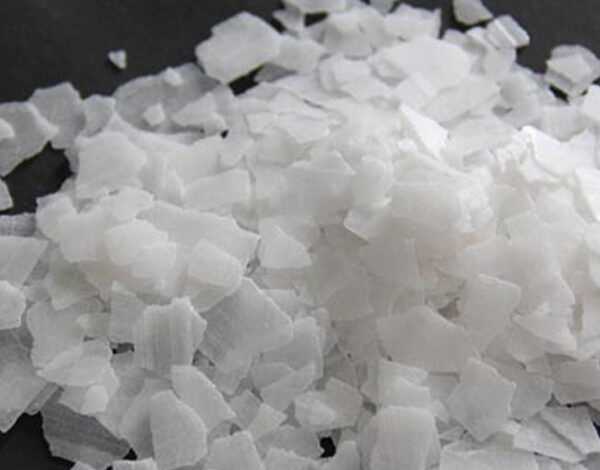Sodium hydroxide
Caustic Soda Flakes
Sodium hydroxide (Caustic soda) is a white, odorless, and solid inorganic compound chemical. It is non-volatile and has high corrosive properties, which easily absorb air moisture and it’s one of the most important industrial chemicals. Its water solution has numerous applications in different industries because of its highly caustic base and alkalescence. Sodium hydroxide, with the formula NaOH, also known as lye and caustic soda, is a popular strong caustic base.
Product description:
Product Information: Sodium Hydroxide (NaOH), also known as Soda caustic, is a silk-like substance that is white in color, extremely absorbent of moisture, and generates a considerable degree of heat when dissolved in water. It is available as flakes of white color in solid form. Chemical analysis of the substance is as follows:

HAZARD IDENTIFICATION
- Danger! Causes eye and skin burns.
- Causes digestive and respiratory tract burns.
- absorbs moisture from the air.
- EXTREMELY CORROSIVE.
- Fatal if inhaled.
- Avoid to swallowed.
- Causes severe skin burns and eye damage.
- Can cause blindness, permanent scarring and death.
- Toxic if swallowed and in contact with skin.
- Suspected of damaging the unborn child.
- Suspected of causing genetic defects.
- May cause damage to cardiovascular, respiratory, nervous, and gastrointestinal systems and liver and blood through prolonged or repeated exposure.
- Harmful to aquatic life.

PACKAGING, TRANSPORT & SAFE HANDLING
Caustic soda flake packing have different kind but there is very important item that must noted, this item
is transporting and storing the sodium hydroxide flake if packing of sodium hydroxide flake have low
quality the moisture of weather will penetrate into sodium hydroxide packing so the caustic soda flake will
stick together and will turn into lump mode so the quality of sodium hydroxide flake will reduce and would
not be use able after a little time.
Sodium hydroxide flake packing must be from two ply laminated polypropylene
bags that sealed completely with strong polyester yarn, if using normal yarn for
sealing the bags after a little time sodium hydroxide flake will solve the yarn.
Best Packing of Caustic soda flake would be 25 kg PP bags and for keeping
away from injuries when transporting its better putting 25 kg bags in Jumbo bags.
• Jumbo Bags (each has the weight of 1 MT)
• PP/PE Bags (each has the weight of 25 Kg)
• PE Drums (each has the weight of 5 Kg)

Sodium Hydroxide Uses
Sodium hydroxide [Na(OH)] is a strong alkaline substance that dissociates completely in water to sodium (Na+) and hydroxyl (OH–) ions. The dissolution/dissociation in water is strongly exothermic, so a vigorous reaction occurs when sodium hydroxide is added to water.
Sodium hydroxide is used to neutralize acid solutions and make sodium salts. Sodium hydroxide is used in the manufacture of rayon, mercerised cotton, soap, paper, aluminium, petroleum products and in metal cleaning, electrolytic extraction of zinc, tin plating and oxide coating. Mercerisation is a treatment for cellulosic material, typically cotton threads, that strengthens them, gives them a lustrous appearance and increases cotton’s affinity to dye, and resistance to mildew.
Sodium hydroxide solutions hydrolyze fats to form soaps, they precipitate bases and most metals (as hydroxides) from aqueous solutions of their salts.
Sodium hydroxide is a common constituent of many household and industrial cleaners including oven cleaners and beeline cleaners. Sodium hydroxide is present as a stabilizing agent in bleach.
It may also be found in dishwasher detergents. Some paint strippers and drain cleaners contain sodium hydroxide. It is used as a pipe line cleaner in dairies, bars and public houses.
Sodium hydroxide has mainly industrial uses. On a global level the main uses are :
Organic chemicals (18 %)
Pulp and paper (18 %)
Inorganic chemicals (15 %)
Soaps, detergents and textile (12 %)
Alumina (8 %)
Water treatment (5 %)
Others (25 %)
Sodium hydroxide is also used by the drink and beer industry to clean non-disposable bottles. Although main quantities are used by the industry (large enterprises) it is also widely used by small and medium sized enterprises. Sodium hydroxide is used for example for disinfection and cleaning purposes. Sodium hydroxide (up to 100 %) is also used by consumers. Sodium hydroxide is used at home for drain and pipe cleaning, wood treatment and it also used to make soap at home 6). Sodium hydroxide is also used in batteries and in oven-cleaner pads. The previously mentioned uses are only examples of uses but probably many other uses do occur because sodium hydroxide is widely available. However, significant differences in uses between countries can be expected.
Small amounts of sodium hydroxide are produced as a by-product and released into the car interior when motor car air bag systems are activated. Air bag systems are triggered when a sensor in the bumper sends an electrical charge to a gas generator containing sodium azide (70 g). A chemical reaction is initiated that produces nitrogen gas from the sodium azide.


